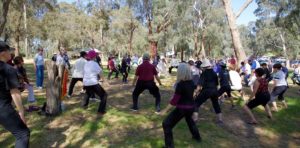Improve Executive Function with Mindful Movement
By John M. de Castro, Ph.D.
“Tai Chi may just be a form of exercise that will preserve a sharp mind!” – Tai Chi and Health
Human life is one of constant change. We revel in our increases in physical and mental capacities during development, but regret their decreases during aging. Over time there is a systematic progressive decline in every system in the body, the brain included. This includes our mental abilities which decline with age including impairments in memory, attention, and problem solving ability. It is inevitable and cannot be avoided. Using modern neuroimaging techniques, scientists have been able to view the changes that occur in the nervous system with aging. In addition, they have been able to investigate various techniques that might slow the process of neurodegeneration that accompanies normal aging. They’ve found that mindfulness practices reduce the deterioration of the brain that occurs with aging restraining the loss of neural tissue.
Mindfulness practices have been shown to improve cognitive processes and mood while gentle mindful movement exercises such as Tai Chi, Qigong and Baduanjin mind-body training have been shown to slow age related cognitive decline. But, most studies of mindful movement effects on cognitive decline and mood, are performed in the elderly. Hence, the effectiveness of these practices with younger people to enhance cognitive function and mood have not been extensively studied. In today’s Research News article “Baduanjin Mind-Body Intervention Improves the Executive Control Function.” See summary below or view the full text of the study at: https://www.ncbi.nlm.nih.gov/pmc/articles/PMC5233682/, Chen and colleagues studied the effects of Baduanjin mind-body practice on mood and cognitive function of college students.
They recruited college students and randomly assigned them to receive either 8 weeks, 5 days per week, for 90 minutes per day of Baduanjin mind-body training or progressive muscle relaxation training. The Baduanjin mind-body training consisted of 8 movements for limbs, body-trunk, and eye movements. The participants were measured before and after training for mood and cognitive executive function with a flanker task. The flanker task required the participants to respond to the direction of an arrow when distracting arrows were present alongside the target arrow. This test for attention and filtering of irrelevant information. During the flanker task their brain activity was measured with near-infrared spectroscopy which measures blood flows in the brain.
They found that following Baduanjin mind-body training, but not relaxation training, there was a significant decrease in the levels of depression and increase in flanker task performance with incongruous distracting stimuli. The flanker task improvement demonstrated that the Baduanjin mind-body training participants were better able to filter out distracting material. In addition, during the flanker task, with distracting incongruent stimuli present, the Baduanjin mind-body training group had an increase in blood flow in the left prefrontal cortex while the relaxation group did not. This suggests that the Baduanjin mind-body training produced a change in the brain that may underlie the improvements in mood and executive function.
It has been demonstrated that increases in the activity and size of the prefrontal cortex occurs with improved executive function ability. This suggests that Baduanjin mind-body training changes the brain to improve cognitive function. It is quite remarkable that such a gentle practice can produce neural changes resulting in such beneficial effects. It is also important that these effects were produced in young participants. So, the benefits of participation in mindful movement programs are not restricted to the elderly and do not just protect against cognitive decline but can improve cognitive function even for those at the peak of their abilities.
Baduanjin mind-body training is a gentle practice, completely safe, can be used by anyone, including the elderly and sickly, is inexpensive to administer, can be performed in groups or alone, at home or in a facility or even public park, and can be quickly learned. In addition, it can also be practiced in social groups without professional supervision. This can make it fun, improving the likelihood of long-term engagement in the practice.
So, improve executive function with mindful movement.
“A comparison of the effects of regular sessions of tai chi, walking, and social discussion, has found tai chi was associated with the biggest gains in brain volume and improved cognition.” – About Memory
CMCS – Center for Mindfulness and Contemplative Studies
This and other Contemplative Studies posts are also available on Google+ https://plus.google.com/106784388191201299496/posts and on Twitter @MindfulResearch
Study Summary
Chen, T., Yue, G. H., Tian, Y., & Jiang, C. (2016). Baduanjin Mind-Body Intervention Improves the Executive Control Function. Frontiers in Psychology, 7, 2015. http://doi.org/10.3389/fpsyg.2016.02015
Abstract
This study aims at comparing the effects of the Baduanjin mind-body (BMB) intervention with a conventional relaxation training program on enhancing the executive function. The study also attempts to explore the neural substrates underlying the cognitive effect of BMB intervention using near-infrared spectroscopy (NIRS) technique. Forty-two healthy college students were randomly allocated into either the Baduanjin intervention group or relaxation training (control) group. Training lasted for 8 weeks (90 min/day, 5 days/week). Each participant was administered the shortened Profile of Mood States to evaluate their mood status and the flanker task to evaluate executive function before and after training. While performing the flanker task, the NIRS data were collected from each participant. After training, individuals who have participated in BMB exercise showed a significant reduction in depressive mood compared with the same measure before the intervention. However, participants in the control group showed no such reduction. The before vs. after measurement difference in the flanker task incongruent trails was significant only for the Baduanjin intervention group. Interestingly, an increase in oxygenated hemoglobin in the left prefrontal cortex was observed during the Incongruent Trails test only after the BMB exercise intervention. These findings implicate that Baduanjin is an effective and easy-to-administering mind-body exercise for improving executive function and perhaps brain self-regulation in a young and healthy population.
